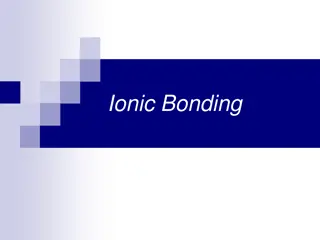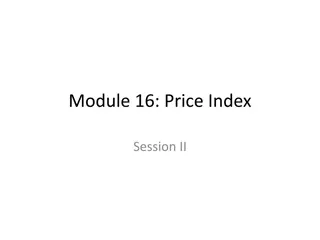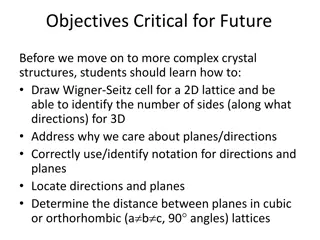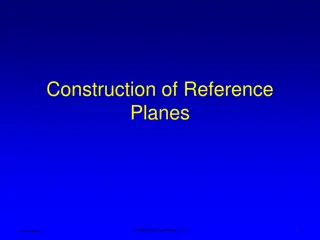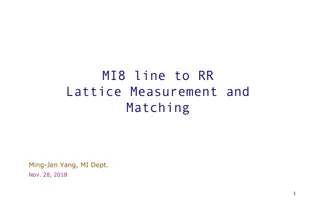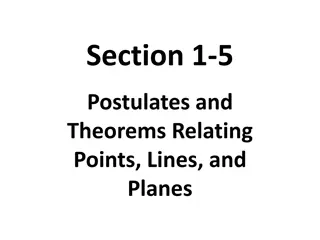Understanding Crystal Lattice Planes and Indices
Exploring the significance of crystal lattice planes in determining parameters, diffraction methods, and orthogonal systems. Discover how to identify planes and calculate distances in various lattices using Miller indices. Visual aids provide clarity on hexagonal structures and symmetry in crystallography.
Download Presentation

Please find below an Image/Link to download the presentation.
The content on the website is provided AS IS for your information and personal use only. It may not be sold, licensed, or shared on other websites without obtaining consent from the author. Download presentation by click this link. If you encounter any issues during the download, it is possible that the publisher has removed the file from their server.
E N D
Presentation Transcript
Close packed crystals A plane B plane C plane A plane ABCABCABC packing [Face Centered Cubic (FCC)] ABABAB packing [Hexagonal Close Packing (HCP)]
Hexagonal Has Different Notation Hexagonal structure: a-b plane (2D hexagon) can be defined by 3 vectors in plane (hkl) m e 3D structure can be defined by 4 miller indices (h k l m) Third miller index not independent: h + k = -l k h l Have more on HCP planes in the Additional Materials tab of website
Indices of a Family Sometimes several nonparallel planes may be equivalent by virtue of symmetry, in which case it is convenient to lump all these planes in the same Miller Indices, but with curly brackets. 100 { } 100 ( ), ( 010 ), ( 001 0 ( ), 1 0 ), ( 00 1 1 ( ), 00 ) 111 { } 111 ( ), 11 ( 1 1 ( ), 1 1 ( ), 1 11 1 ( ), 1 1 1 ( ), 1 1 ( ), 1 1 1 1 ( ), 1 ) 1 Thus indices {h,k,l} represent all the planes equivalent to the plane (hkl) through rotational symmetry.
Indices of a Family Sometimes several nonparallel planes may be equivalent by virtue of symmetry, in which case it is convenient to lump all these planes in the same Miller Indices, but with curly brackets. 100 { } 100 ( ), ( 010 ), ( 001 0 ( ), 1 0 ), ( 00 1 1 ( ), 00 ) 111 { } 111 ( ), 11 ( 1 1 ( ), 1 1 ( ), 1 11 1 ( ), 1 1 1 ( ), 1 1 ( ), 1 1 1 1 ( ), 1 ) 1 Thus indices {h,k,l} represent all the planes equivalent to the plane (hkl) through rotational symmetry. Similarly, families of crystallographic directions are written as: 100 100 [ ], [ 010 ], [ 001 0 [ ], 1 0 ], [ 00 1 1 [ ], 00 ]
Why are planes in a lattice important? (A) Determining crystal lattice parameters * Diffraction methods measure the distance between parallel lattice planes of atoms to determine the lattice parameters (and other stuff)
Identify these planes y x How does the distance between the planes change?
If you have orthorhombic tetragonal or cubic lattice, use this formula for distance between planes
If you have orthorhombic tetragonal or cubic lattice, use this formula for distance between planes
What is the distance between the (111) planes on a cubic lattice of lattice parameter a?
What is the distance between the (111) planes on a cubic lattice of lattice parameter a?
What is the distance between the (111) planes on a cubic lattice of lattice parameter a? Find the distance between (1 2 3) in a cubic lattice?
What is the distance between the (111) planes on a cubic lattice of lattice parameter a? Find d111 in a tetragonal lattice where c = 2 a = 2b?
Non-closed packed structures For more information: https://en.wikibooks.org/wiki/Introduction_to_Inorganic _Chemistry/Ionic_and_Covalent_Solids_-_Structures
Packing isnt the only consideration when building a lattice. Other non close-packed structures In covalently bonded materials, bond direction is more important than packing graphite diamond How would you do packing factors in a system with more than one element?
Packing isnt the only consideration when building a lattice. Other non close-packed structures In covalently bonded materials, bond direction is more important than packing graphite diamond What is close packed direction? How would you do packing factors in a system with more than one element?
Simple Crystal Structures Diamond Crystal class Td (tetrahedral) - Each atom has 4 nearest- neighbors (nn). What elements might benefit from 4 neighbors?
Simple Crystal Structures Diamond Crystal class Td (tetrahedral) - Each atom has 4 nearest- neighbors (nn). What elements might benefit from 4 neighbors? What type of lattice?
Simple Crystal Structures Diamond Crystal class Td (tetrahedral) - Each atom has 4 nearest- neighbors (nn). What elements might benefit from 4 neighbors? What type of lattice? Can be interpreted as two combined fcc structures One atom at origin Other atom displaced along diagonal ( , , ), Define all Includes C, Si, Ge, -Sn
Defining the Crystal Structure Lattice face centered cubic (fcc). The fcc primitive lattice is generated by r = n1a1+n2a2+n3a3 with primitive lattice vectors:
Defining the Crystal Structure Lattice face centered cubic (fcc). The fcc primitive lattice is generated by r = n1a1+n2a2+n3a3 with lattice vectors: a1 = a(0,1,1)/2, a2 = a(1,0,1)/2, a3 = a(1,1,0)/2 Basis set:2 atoms (specify element) at (000) and ( , , ). Diamond: 2 identical atoms in basis (e.g. 2 C) fcc lattice
Defining the Crystal Structure Lattice face centered cubic (fcc). The fcc primitive lattice is generated by r = n1a1+n2a2+n3a3 with lattice vectors: a1 = a(0,1,1)/2, a2 = a(1,0,1)/2, a3 = a(1,1,0)/2 (NOTE: The ai s are not mutually orthogonal!) Basis set:2 atoms (specify element) at (000) and ( , , ). Diamond: 2 identical atoms in basis (e.g. 2 C) fcc lattice Zincblende: 2 different atoms in basis and fcc lattice For FCC 2 atom ABCABC stacking, it is called zinc blende
For ABAB stacking it is called wurzite structure (fcc zincblende was ABCABC) Some compounds can have either structure (i.e., GaN, SiC) Many semiconductors have the Wurtzite Structure Tetrahedral coordination:Each atom has 4 nearest-neighbors (nn). Basis set:2 atoms.Lattice hexagonal close packed (hcp). A Unit Cell looks like hcp primitive lattice vectors : a1 = c(0,0,1) a2 = ( )a[(1,0,0) + (3) (0,1,0)] a3 = ( )a[(-1,0,0)+ (3) (0,1,0)]




